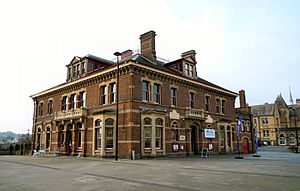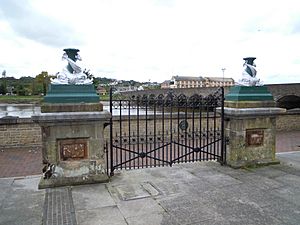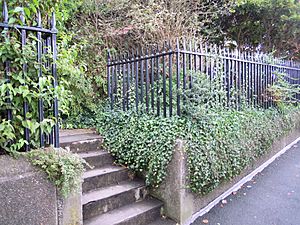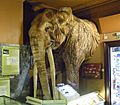Museum of Barnstaple and North Devon facts for kids

Museum of Barnstaple and North Devon in 2018
|
|
| Lua error in Module:Location_map at line 420: attempt to index field 'wikibase' (a nil value). | |
| Established | 1888 |
|---|---|
| Location | Barnstaple, Devon |
The Museum of Barnstaple and North Devon is a super interesting place in Barnstaple, Devon. It's a local museum that tells the story of the North Devon area. You can explore everything from ancient times to the Victorian era here. The museum building itself is very special. It has been a Grade II listed building since 1988, which means it's an important historical structure.
Contents
About the Museum Building
The museum building was first built in 1872 for a person named William Thorne. Later, it was sold to the Barnstaple Bridge Trust in 1876. Then, William Frederick Rock bought it. The building is made of red bricks with stone and terracotta decorations. Its roof is slanted and covered with slates. It also has a flat part in the middle with pretty iron railings and five red brick chimneys.
The building is shaped like a square and has a courtyard inside. On the right side, there's a smaller part that might have been a coach-house. Inside, you'll find a beautiful wooden staircase. It's built in the Jacobean style, with twisted railings and large carved newel posts. The entrance hall also has a cool Gothic stone fireplace.
Behind the museum, facing the river, there's a small garden. It's surrounded by iron railings with pointy tops. These railings are also part of the building's special historic status. Even the gate posts and gates next to the building are listed as important historical features.
Museum History and Founder
The museum started in 1888 as the North Devon Athenæum. It was founded by William Frederick Rock. He wanted it to replace an older place he had created in 1845, called the Barnstaple Literary and Scientific Institute. The new building was a library and a museum. It also kept important records for Barnstaple.
William Frederick Rock had a very modern idea for his time. He allowed both men and women to share the reading rooms. He believed that having separate rooms might make women gossip instead of read! The person in charge of the library used to live in the building until the 1930s.
In 1956, the Devon County Library Service moved into the main floor. They had been in a much smaller building across the road. Then, in 1988, the library collection moved again. It went to a new, specially built place called the North Devon Library and Record Office. The museum collection stayed in the building. It was then loaned to the Museum of Barnstaple and North Devon, which took over the space.
What You Can See at the Museum
The museum has many collections and displays. They show the natural world and human history of North Devon. You can explore different galleries, like the Tarka Gallery. This gallery is about the famous otter from the books. There's also the Story of North Devon gallery.
You can see collections from the Royal Devon Yeomanry and the Royal 1st Devon Yeomanry. These are military collections. The museum also displays furniture made by Shapland & Petter. There's a collection of 17th-century pewter and ceramics from the area. This includes special Art Pottery by Brannam Pottery, William Leonard Baron, and Alexander Lauder.
One amazing display is a full-size model of the front half of the Barnstaple Elephant. This was a rare straight-tusked elephant that lived a very long time ago. It became extinct in the UK around 115,000 years ago. Its fossil was found in Barnstaple in 1844! In the prehistory gallery, you can see some tusk and bone pieces from this elephant. Some whole teeth were even sent to the Natural History Museum in London.
In 2005, the museum was chosen as one of ten places for the £100,000 Gulbenkian Prize for Museum of the Year. This was for their work on the history of Shapland & Petter. This company was a famous manufacturer from Barnstaple.
The museum also has a Gift Shop where you can buy souvenirs. There's a Tearoom if you want a snack or drink. You can also find a Tourist Information Centre and a Visitor Reception.
In May 2018, the museum closed for a while to build an extension. It reopened in October 2019. The big Grand Opening in April 2020 was delayed because of the COVID pandemic. In 2023, the Museum became part of Arts Council England's funding program. This means it's now a National Portfolio Organisation.
Gallery











